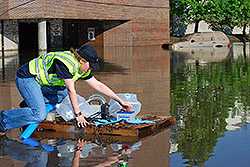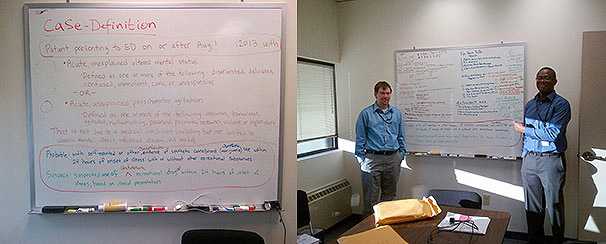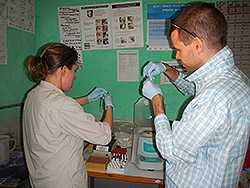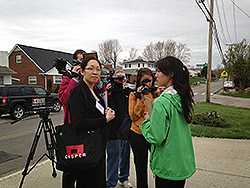What do EIS officers do at NCEH/ATSDR?

Ellen Yard, PhD (EIS '09) and Matt Murphy, PhD (EIS '07) in Kentucky responding to floods.
EIS officers are involved in a variety of opportunities including leading epidemiological investigations, analyze large national datasets, serve as technical advisors, and respond to requests for assistance from state, local, tribal, territorial, and international governments.
EIS officers are placed in the
Agency for Toxic Substances and Disease Registry (ATSDR)
National Center for Environmental Health (NCEH)
- NCEH Division of Emergency and Environmental Health Services
- NCEH Division of Environmental Hazards and Health Effects
Recent projects conducted by EIS officers include the following topics:

Ellen Yard, PhD (EIS '09) checking water quality during flood in Tennessee.
- Investigated LeadPoisoning in Flint, MI
- Provided technical assistance in assessing unregulated drinking water use on tribal lands
- Investigated the association between prenatal exposure to polychlorinated biphenyls (PCBs) and cognitive development in young girls
- Evaluated the surveillance of dietary supplement-induced liver injury by the National Poison Data System
- Conducted a surveillance evaluation of the National Poison Data System for synthetic marijuana
- Characterized health effects from hand sanitizer exposure among children
- Evaluated use of media reports for determining mortality rates during Hurricane Sandy
- Explored the relationship between CDC’s Social Vulnerability Index and disaster-related deaths using statistical and spatial methods
- Assessed adverse health effects reported to the National Poison Data System from exposure to e-cigarettes
- Investigation of Asthma-Related emergency room visits
- Conducted a Community Assessment for Public Health Emergency Response (CASPER) for Rapid Identification of Disaster Response and Recovery Needs of Communities Affected by the Elk River Chemical Spill

Ethan Fechter-Leggett, DVM (EIS '13) and Olaniyi Olayinka, MBBS (EIS '13) during an investigation of an outbreak of severe-illnesses associated with the reported use of synthetic cannabinoids - Colorado.
You can read more about investigations conducted by EIS officers at NCEH in the following articles:

Ellen Yard, PhD (EIS '09) and Kevin Chatham-Stephens, MD (EIS '13) label blood samples obtained during an investigation of liver disease in Tigray, Ethiopia.
- Hsu J, Del Rosario MC, Thomasson E, Bixler D, Haddy L, Duncan MA. Hospital Impact After a Chemical Spill That Compromised the Potable Water Supply: West Virginia, January 2014.Disaster Med Public Health Prep. 2017 Mar 6:1-4.
- Burrer S, Fechter-Leggett E, Wolkin A, Bayleyegn T, Noe RS, Hsu J, et al. Assessment of impact and recovery needs in communities affected by the River chemical spill — West Virginia, April 2014. Public Health Reports. 2017 Feb
- Thomasson ED, Scharman EJ, Fechter-Leggett E, Bixler D, Ibrahim S, Duncan MA, Hsu J, et al. Acute health effects after the Elk River chemical spill, West Virginia, January 2014. 2017, Feb
- Carroll Y, Rashid F, Falk H, Howley M. Examples of applied public health through the work of the Epidemic Intelligence Service officers at CDC’s National Center for Environmental Health: 2006–2015. Public Health Reviews 2017 Jan
- Hsu J, Qin X, Beavers SF, Mirabelli MC. Asthma-Related School Absenteeism, Morbidity, and Modifiable Factors. Am J Prev Med. 2016 Feb 9
- Severe Illness Associated with Reported Use of Synthetic Cannabinoids - Mississippi, April 2015 (MMWR)
- Calls to Poison Centers for Exposures to Electronic Cigarettes — United States, September 2010–February 2014 (MMWR)
- Whitfield GP, Paul P, Wendel AM. Active transportation surveillance across five systems – United States 1999-2012. MMWR Surveillance Summaries. 2015; 64(SS07): 1-17.
- Disaster Response and Recovery Needs of Communities Affected by the Elk River Chemical Spill, West Virginia, April 2014 [PDF - 1.34 MB]
- Notes from the Field: Severe Illness Associated with Reported Use of Synthetic Marijuana — Colorado, August–September 2013
- Chlorine Gas Exposure at a Metal Recycling Facility --- California, 2010
- Meet a Disease Detective Hunting Ebola in Dallas
- Falk H and Briss P. Environmental- and Injury-related Epidemic-Assistance Investigations, 1946–2005. American Journal of Epidemiology 2011; 174 (11)
- Falk H. Environmental Health in MMWR — 1961–2010. MMWR 2011,60:86- 96.

Joy Hsu, MD, (EIS '13) communicating with media during a field investigation of the public health effects of a chemical release in West Virginia.
You can solve a virtual outbreak by using the CDC iPAD application: Solve the Outbreak at http://www.cdc.gov/mobile/Applications/sto/.
- Page last reviewed: March 15, 2017
- Page last updated: March 15, 2017
- Content source:


 ShareCompartir
ShareCompartir